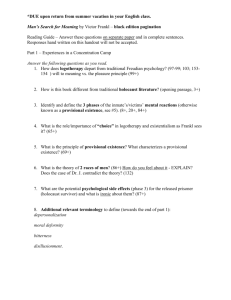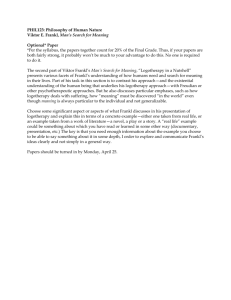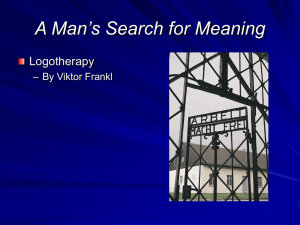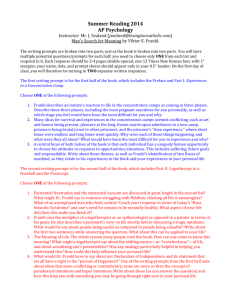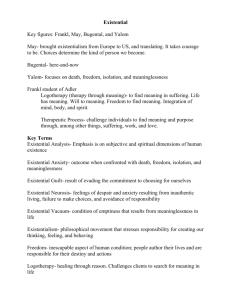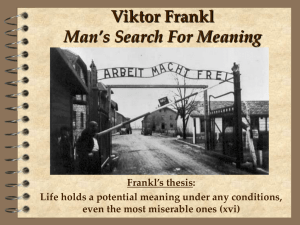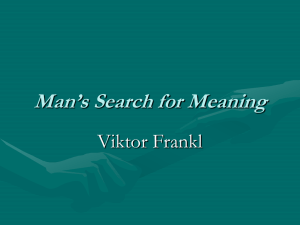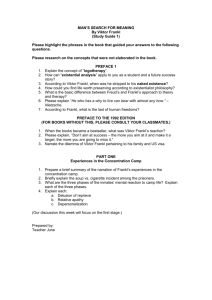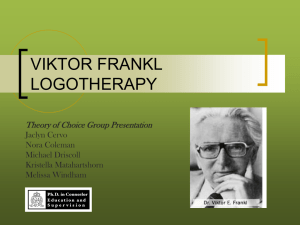Today we have a considerably enriched repertoire of methods to
advertisement
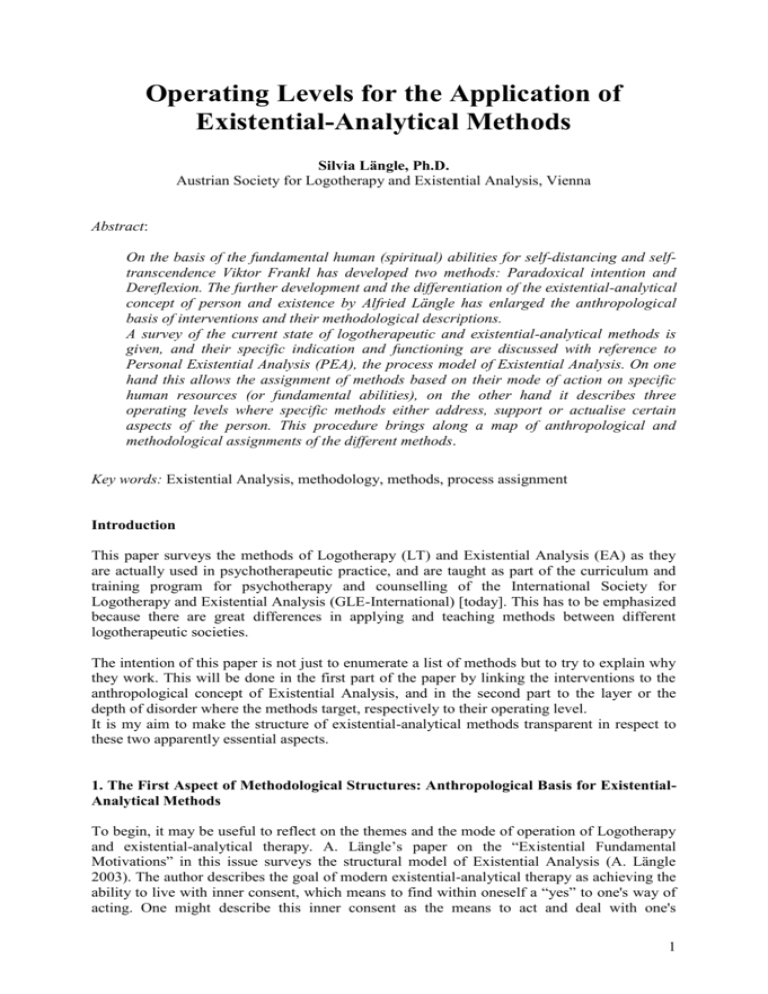
Operating Levels for the Application of Existential-Analytical Methods Silvia Längle, Ph.D. Austrian Society for Logotherapy and Existential Analysis, Vienna Abstract: On the basis of the fundamental human (spiritual) abilities for self-distancing and selftranscendence Viktor Frankl has developed two methods: Paradoxical intention and Dereflexion. The further development and the differentiation of the existential-analytical concept of person and existence by Alfried Längle has enlarged the anthropological basis of interventions and their methodological descriptions. A survey of the current state of logotherapeutic and existential-analytical methods is given, and their specific indication and functioning are discussed with reference to Personal Existential Analysis (PEA), the process model of Existential Analysis. On one hand this allows the assignment of methods based on their mode of action on specific human resources (or fundamental abilities), on the other hand it describes three operating levels where specific methods either address, support or actualise certain aspects of the person. This procedure brings along a map of anthropological and methodological assignments of the different methods. Key words: Existential Analysis, methodology, methods, process assignment Introduction This paper surveys the methods of Logotherapy (LT) and Existential Analysis (EA) as they are actually used in psychotherapeutic practice, and are taught as part of the curriculum and training program for psychotherapy and counselling of the International Society for Logotherapy and Existential Analysis (GLE-International) [today]. This has to be emphasized because there are great differences in applying and teaching methods between different logotherapeutic societies. The intention of this paper is not just to enumerate a list of methods but to try to explain why they work. This will be done in the first part of the paper by linking the interventions to the anthropological concept of Existential Analysis, and in the second part to the layer or the depth of disorder where the methods target, respectively to their operating level. It is my aim to make the structure of existential-analytical methods transparent in respect to these two apparently essential aspects. 1. The First Aspect of Methodological Structures: Anthropological Basis for ExistentialAnalytical Methods To begin, it may be useful to reflect on the themes and the mode of operation of Logotherapy and existential-analytical therapy. A. Längle’s paper on the “Existential Fundamental Motivations” in this issue surveys the structural model of Existential Analysis (A. Längle 2003). The author describes the goal of modern existential-analytical therapy as achieving the ability to live with inner consent, which means to find within oneself a “yes” to one's way of acting. One might describe this inner consent as the means to act and deal with one's 1 situations in a way that leads to self-affirmation and to assuming responsibility for one's actions. Existential freedom means to be able to live with affirmation, with consent. The access to the free will of the person proves to be the basis of a mature, meaningful life, a life characterized by self-and other-affirmation and responsibility. As a consequence, all methods of LT and EA share the common goal of achieving this personal, existential freedom. Thus far I have described the general direction of interventions. In order to develop a more detailed structure of methods we have to take a more internal look at the structure of existential analytical anthropology. 1.1. Anthropology of Classical Logotherapy (V.E. Frankl) Which steps and personal processes enable us to live existential freedom? Classical Existential Analysis, which is based on the anthropology formulated by V. E. Frankl (see e.g. Frankl 1985, in German e.g. Frankl 1959, 1986, 1991), postulates two basic abilities of the noetic person: Self-detachment and Self–transcendence, which are basic conditions for existential being. Frankl describes these conditions as a specific way of being in the existential, noetic dimension, in which he contrasts with the psychic and somatic (or biological) dimensions. SELF-DETACHMENT emphasizes the ability of the noetic person to oppose his or her psychological and biological mechanisms or, as Frankl says: “Man is free to rise above the plane of somatic and psychic determinants of his existence. By the same token a new dimension is opened. Man enters the dimension of the noetic, in counter distinction to the somatic and psychic phenomena. He becomes capable of taking a stand not only toward to the world but also toward himself.” (Frankl 1985, 19) Since being a person means to be able to distance oneself from the life’s conditions and from oneself by mobilizing one’s will to freedom, the following question necessarily arises: “Towards what shall the will be directed?” The answer lies in the concept of SELF-TRANSCENDENCE. I would like to give a description in Viktor Frankl’s own words, since they represent his Logotherapy in a nutshell. “It is a tenet of Logotherapy that self-transcendence is the essence of existence. This tenet means that existence is authentic only to the extent to which it points to something that is not itself. […] Man, I should say, realizes and actualizes values. He finds himself only to the extent to which he loses himself in the first place, be it for the sake of something or somebody, for the sake of a cause or a fellowman, or ‘for God’s sake’. Man’s struggle for his self and his identity is doomed to failure unless it is enacted as dedication and devotion to something beyond his self, to something above his self.” (Frankl 1985, 87) Frankl stresses that human beings are not prisoners of their feelings or their environments, but that they can transcend their egocentrism and view their situation from a different perspective. Human beings are free to choose and decide where to turn, and to bededicate to something or someone beyond themselves. But in Frankl`s view only the process of leaving oneself behind, of neglecting oneself leads to existential being, to personal fulfilment. In elaborating his concept of psycho-noetic antagonism, Frankl stresses that one has to leave behind the psycho-somatic dimension and conditions and transcend these restraints. Frankl`s formulations concerning his anthropology lead to an ambiguous one-sidedness, which may also have implications for the person's relation to him-or herself. This topic, for example, concerns self-experience in the psychotherapeutic training program. (cf. S. Längle 2001, 20f, A. Längle 1996c) 2 1.2. Anthropology of the Personal Existential Analysis (A. Längle) Frankl has seen a psycho-noetic antagonism as a starting point in every psychotherapy (Frankl 1959, 686). But in modern Existential Analysis this paradigm has changed substantially. The one-sided openness of the person to the world is supplemented by the “personal turn” which is, as the name says, a turn to the conditions of the person as well as a “turn to emotionality” (cf. A. Längle 1999a, b). Here we have a great change in comparison to Frankl’s original Logotherapy. In addition to seriously considering reflection, reason and conscience, Personal Existential Analysis (PEA) gives equal attention to human impulsivity, instinctiveness and corporeality. These aspects are discussed in greater detail in the publication on the PEA of A. Längle in this volume (see also A. Längle 1993). In our context it is of substantial importance to note that the PEA model does not view the noetic and psycho-physical dimensions as inevitably and a priori antagonistic. The noetic does not have primacy over or supersede the psychological and physical dimensions. On the contrary; in first instance they are one. The person bears the innate capacity of being impressed, being acted upon, through sensations, feelings, impulses, and spontaneous reactions show a unity of the noetic with the psychological and somatic dimension. The same applies to the active expressions of the person. Here, too, the noetic exists in harmony with psychological and physical forces, as well as the de facto conditions of the world. Only when human beings make a conscious decision do they step out of this psychophysical unity. Taking a stand relates to a spirituality (which, in this context, is not understood in the religious sense) that is beyond the situational restrictions. This signifies, in respect to personal resources, that, in addition to SD and ST, human beings have the ability to overcome antagonism, and it is this ability that guards and protects human identity: This ability points towards self acceptance. This SELF-ACCEPTANCE comes from an openness towards oneself, which likewise means, to accept an exterior reality as well as what occurs in my inner awareness, what is going on in myself, what is set in motion in myself, and to dedicate oneself to both with equal seriousness. As a consequence, human beings remain in continual dialog with the external world as well as with the internal world. Figure 1: Innenwelt (Intimität) = Inner world (Intimacy), Offensein für = being open for, Außenwelt (Andersheit) = Outer world (Otherness) The double way of openness as a result of the double reference Innenwelt PERSON Außenwelt (Intimität) = Offensein für... (Andersheit) Figure 1: The double way of openness of the person as a result of the double reference Taking a position opens up the possibility of a dialogue, which now turns in two directions and, as a consequence of the person's wholeness, this dialog has a process-oriented interchange between inside and outside. 3 In sum, we find in the current version of EA a third personal resource in addition to the human capacity for self-detachment and self-transcendence outlined by traditional LT, the ability of self-acceptance (SA). These are the three pillars that make a continuous dialog of the person possible. Standing in this dialog refers to the “I-THOU” relationship, described by M. Buber (Buber 1973), as the basis of vital, existential encounter and relationship. This existential way of living is always an actualisation of one’s personal freedom by remaining open to the situation and by giving one’s own answers. This actualisation is the aim of every existential therapy and counselling. Actualizing personal freedom, as the general aim of any existential analytical intervention, focuses on SD, ST and SA in particular as the human resources which lead to this personal freedom. In these three personal abilities we find a first structural aspect of EA methods. The methods differ depending on whether they aim at SD, ST or SA; for instance, it is well known that Paradoxical Intention aims at SD and Dereflexion at ST. This leads to the second part of the paper. 2. The Second Structural Aspect of the Methods of EA and LT: Mode of Operation Today we have a considerably enriched repertoire of methods to pursue the above mentioned aims. Most of them were developed by A. Längle in the eighties and early nineties and published in German. We will survey these methods in respect to the two structural aspects, the anthropological as well as the methodological. A closer look at the methods reveals three different layers or levels differentiated by their manner of working. 2.1 First Layer: Resource-oriented On the first level we find the classical methods as they were developed by V. Frankl: Paradoxical Intention, Dereflection and Modification of Attitude (e.g. Frankl 1970, 100ff and Frankl 1985, 140ff). Here we follow the classical trace of intervention as initiated by V. Frankl: It directly draws upon personal resources. Implicitly these interventions are based on the presumption of sufficient access to personal abilities. The counsellor or therapist leads the patient in an internal and external dialogue based upon the assumption that the patient will find answers and thereby immediately experience his or her own competence or ability for him/herself. The patient spontaneously finds his or her way, which means he or she becomes conscious of previously forgotten experiences and becomes open to novel ones as well. These experiences make the patient aware of his or her own integrity and authenticity. Distinct from psychotherapy, which guides a longer process of development, these methods work where experiences are accessible spontaneously, or at least relatively spontaneously, with the help of a supportive, but stimulating counsellor. The result may be a changed perspective or a fresh look at an old experience, which means an opening and widening of the impression received. Existential-analytic therapists may apply Paradoxical Intention, Dereflexion or the Modification of Attitude if the patient’s sense of personal competence has remained intact, but is not freely accessible because of the hindering experiences of problems. In order to make personal resources accessible the patient needs an impulse through an empathic, therapeutic relationship. In such cases the patient may be unable to dialogue and reflect in respect to specific topics, but the general ability or competence remains intact. The resource-provoking methods have one basic notion in common: They break through a secondary cycle of instability and produce an attitude of expectancy or a phenomenological openness in the face of threatening situations. 4 Frankl has demonstrated how such circle mechanisms form the basis of a self-preserving process that leads increasingly into an attitude of avoidance. (cf. Frankl 1985, 143ff; Frankl 1970, 102ff) More specifically, the symptom, as the starting point of the vicious circle, has a destabilizing effect on the patient. This experience of insecurity or anxiety leads to increased attention and expectancy, which, in turn, reinforces the symptom. > Symptom Anxiety < = circle-mechanism Figure 2: The anxiety circle In such a vicious circle of destabilisation anxiety about a certain situation becomes fixed, but can be ameliorated by experiencing the described personal resources: Anticipatory anxiety refers to the experience of an existential threat in certain situations (like blushing in public). Here SD can help to realize that one continues to exist in spite of this anxiety. The appropriate method is Paradoxical Intention. Compulsion to self-observation or Hyperreflection arises from the fear over losing control. Patients with this compulsion are prone to hyperintention regarding security and control with a guaranteed outcome. ST leads to a new openness to become involved with new experiences, as applied in Dereflection. Fixed attitudes often reveal a fear of change towards that which is perceived as lifethreatening. SA leads to a more open view of life; one can dare to go forward with one-self, and to let life come as it may, even if it is not within one’s control. This requires a Modification of Attitude. All these methods activate the patient’s ability to face his or her own insecurity, and challenge him or her to move beyond the role as a victim in relation to his or her anticipatory anxiety or fixations. Let me give a classical example as V. Frankl described it in his literature: “A young physician came to our clinic because of a severe hydrophobia. He had been troubled by disturbances of the autonomic nervous system for a long time. One day he happened to meet his chief on the street, and as the young extended his hand in greeting, he noticed that he was perspiring more than usual. The next time he was in a similar situation he expected to perspire again, and his anticipatory anxiety precipitated excessive sweating. It was a vicious circle; hyperhydrosis provoked hydrophobia and hydrophobia, in turn, produced hyperhydrosis. We advised our patient, in the event that his anticipatory anxiety should recur, to resolve deliberately to show the people whom he confronted at the time just how much he could really sweat. A week later he returned to report that whenever he met anyone who triggered his anticipatory anxiety, he said to himself, ‘I only sweated out a litre before, but now I am going to pour out at least ten litres!’ what was the result of this paradoxical resolution? After suffering from his phobia for four years, he was quickly able, after only one session, to free himself of it for good by this new procedure.” (Frankl 1985, 143) 5 The methods outlined above do not address the contextual causes of the problems and negate thus the background of the problems. Instead they directly provoke fundamental personal abilities which lead to a stabilisation; they provide a grounding or support and lead once again to a free internal and external dialogue. The task of the first, resource-oriented layer is the restitution of support, protection and space. The patient’s insecurity is challenged by the experience of his or her factual being. This procedure suspends the escalation of insecurity via the vicious circles. In an existential-analytical understanding, the activation of SD, ST and SA are prerequisites for any ability to deal with reality. This potential corresponds to the content of the first fundamental motivation (cf. A. Längle 2003). The experience of being grounded in an existential sense is induced by the experience of the patient’s ability to be in spite of deficiencies, as outlined in the methods presented above. Personal ressources Mode of operation First layer Ressource-oriented SD ST SA PI DR MA Figure 3: The methods of the first level in their relation to existential analytical anthropology 2.2 Second Layer: Problem-oriented The methods of the second layer differ from the resource-methods in the sense that they pay more respect and attention to the patient’s experience of problems or trauma. A deepening and supporting procedure reveals adoptions of opinions and previous judgements, including wishful thinking, avoiding attitudes, and helplessness or powerlessness on behalf of the patient. Through elevating the patient’s emotional state, activating an attitude, a point of view, or clarifying where to go, the patient is required to first reflect and then draw upon his or her personal resources or abilities. This is done in a supportive and dialogical manner that elicits and reinforces untapped resources. More precisely, we find in the second level methods that the patient enters into a relationship with himself and with his or her environment by dealing with the problem. Step by step the methods lead to an increase in interpersonal and intrapersonal contact. Thus, these methods lead to a closeness with oneself and others, and may even result in feelings of profound gratitude. This can bring about an orientation towards one’s experiences of self-worth, replacing the previous orientation towards expectations, wishes, conceptions, or projections. In the existential analytical understanding this process corresponds to the level of development in the second fundamental motivation. (cf. A. Längle 2003) Devotion to something or someone beyond oneself leads to an experience of relationship and closeness to others, but more importantly to oneself, which in turn allows for intimate dealing 6 with one’s own emotions and may induce a re-affirmation of one’s life. The attachment to one’s own life is strengthened. Finally, the affirmation and enjoyment of life provides the basis for every experience of worth (intrinsic value), it opens the patient up even to a sensation of values, which means, the whole person is touched by such an experience of values . An example may clarify the psychotherapeutic work on the second level further. During the medical treatment at a hospital after a suicide attempt the patient was offered the opportunity for psychotherapy. During the initial meeting the 25 year old woman spoke about the reasons behind her act of desperation. She had been addicted to drugs since the age14, and had gone to therapy for the first time at age16. Unfortunately, she relapsed due to the relationship with her chemically-dependent boyfriend. She considered herself a failure. For the last two years she had increasingly contemplated suicide, but had not spoken to anybody about it. Now she was glad that her attempt had failed, and felt as if thousand angels had taken care of her when she jumped down from a bridge onto an underground train. Throughout the last years her life was dominated by drugs, although she recalled a successful period of two years after first going to see a therapist, during which she had been clean. She was happy to have the chance to live again, but at the same time felt afraid to fail again. She doubted if she could manage to abstain from drugs on her own, but this would be the only way of life she desired to live, that would be worth living for her. Although it was an ideal starting point for therapy, her situation also had several limitations. Due to several severely fractured bones, she was to be admitted to a local hospital and was expected to remain there for several weeks, following which she was to be transferred to a rehabilitation and drug treatment centre.. This limited the number of our sessions prior to admission to ten. What could and what should be done in this time? No doubt, priority should be given to the stabilising and supporting her will to live. She could not see a way to turn her wishes into reality, which she subjectively experienced as a lack of willpower. As a result, she viewed herself as a weak person, as a victim of her circumstances and infirmities. She doubted if she could reach her goal. She suffered from low self-esteem, was afraid how things would go on with her boyfriend, but hoped that her mother would help her. Moreover, she felt guilty for what she had done, and this in turn further reduced her self-esteem. In existential analysis the aim of the psychotherapeutic intervention is to re-establish the autonomy of the person by facing the intended project head on. In the case of this young woman we thus employed the “Method of Will-Strengthening” (WSM) (A. Längle 2000b), which applies the following steps: The first step consists in describing her intensions and the positive consequences expected from psychotherapy. Her intention to live without drugs was very clear at that moment. She wanted to start a new life. She wanted to lead a normal life, to be capable to endure struggles and difficulties that life brought her way. A life with drugs was too exhausting for her. The second aspect of the WSM is the elaboration of negative consequences, the articulation of the opposite of her desires. What would she lose by living without drugs? What would she have to give up? Using drugs has been her proven way of dealing with problems. She would have to find and learn ways to endure emotionally-difficult situations. “I used the drugs to close myself off.” What will happen to her when she cannot close herself off anymore? In this second step we had to look thoroughly at her ability to seek immediate relief in drug use and thus avoiding her problems and suffering. Does she have and will she be able to find sufficient courage? In whom and what can she trust? By abandoning her lifestyle of drugs, she also stood to lose her well-known milieu, the environment which supported her habit. It is the task of this second step to make the patient aware of all the obstacles, of all the reasons which work against her intentions. We have to take them as serious as the anticipated positive outcomes. These questions caused her quite a lot of anxiety, because the thin veneer of her well-known lifestyle covered a vacuum; a drug-free life was novel to her and very little grounded this new way of existence. This step concerned not only a question of handling the handicaps. It was a weighty step to encounter herself, to develop an awareness not only for 7 the positive but also for the negative feelings, to come closer to herself. It was arduous to endure the frustrating feelings, to feel how alone she was. But to have survived at least thus far gave her a strong hold and basis for life. The experience of being able to communicate her feelings and to be serious with herself furthered her growing sense of confidence and courage. Her original orientation toward something outside herself was directed back to herself: “What does my intended goal have to do with myself?” The development of the will was a step-bystep decision to live her life on her own terms. To feel this strong will means to be ready to dedicate one’s life to the intended goal. The aspired idea of a drug-free life was no more just a common goal, the obvious thing; it was her own personal decision for her life, with her own reasons for it. In this case, the patient managed to take this step of questioning, of casting doubts. It was important not to cling to illusions about the future or the past. The more we could concretise her hopes and fears the more she could experience the relief of truly being able to remain in her new life. Now she was ready for the third step - the intensification of the positive. In existential analysis this intensification entail a ’getting closer’ to one’s own feelings, which are elicited by the intended goal. This, in turn, leads to an internalisation of this goal. Once again she was reassured of her desire to quit a lifestyle of drugs through the process of exploring what implications this decision had for her entire life. In this final step she managed to recall her previous situation: For her the will to live without drugs was originally a decision for or against life. But now she felt much closer to herself, had become more acquainted with herself. And this provided her with a strong starting point for the long, hard way ahead. She had reduced her fear of failure and had experienced that being alone was not so terrible; she could trust herself. Eventually this trust translated into her fundamental ability to transcend herself, to be able to dedicate her life to something or somebody, and with that decision make her life truly worth living. To the degree that she is able to tap into her personal ability to transcend herself, she is likely to rediscover the strength of her will. This process of the second layer, the exploration of the problem, requires a certain level of ego strength. If the patient cannot overcome such a challenge - like the questioning of her goals – we would have to go a step deeper to develop her personal autonomy and resources as it is commonly accomplished in PEA. These first two levels are the genuine domain of short-term therapy, which ranges between counselling on one side and the therapeutic process-oriented proceeding on the other side. (cf. S. Längle 1996) It is interesting to note that, in this group, we also have three methods, each belonging to one of the fundamental personal abilities SD, ST and SA. Personal Position Finding – PP (A. Längle 1994a) is a three step method to discover one’s personal position or attitude towards a given situation. It introduces a more profound process of SD and ridding oneself of restrictions and constrictions, which come from a missing assessment (or position) and an entanglement in a given situation. Problems in relationships are often indicative of such an entanglement structure of getting mixed up or being involved in a way where one doesn’t know how to go on. In these cases this method is indicated. Will–Strengthening Method - WSM (A. Längle 2000b) is a step-by-step method that works on the will to meaning. The evolution of will happens in the two-fold inner and outer dialog, which clarifies and invigorates the process of realizing one’s goals and in turn strengthens ST. The indications of this method are, on one hand, various types of addiction, and on the other, the frustration of or inability to complete a given task, such as one’s studies or work. 8 Search for Existential Meaning - SEM (A. Längle 1988, for an example also Drexler 2000): This method goes back to the ability to accept oneself which constitutes the foundation on which the person is able to perceive (become aware) and answer the question of meaning. The four steps of SEM relate to the four fundamental motivations of existential analysis. The intended range of application for this method includes situations and states where meaning is lost or where the search for meaning is failing. This often happens after a significant loss or a transition. Now we can extend our scheme: Personal ressources SD ST SA First layer Ressource-oriented PI DR MA Second layer Problem-oriented PP WSM SEM Mode of operation Figure 4: The relation in two levels between ea methods and anthropology 2.3 Third Level: The Process of Developing a Personal Dialogue – Person-oriented With increasing personal support the patient’s access to his or her personal resources changes from 1) activation by a direct appeal to untapped potential at the first level to 2) a step-by-step uncovering and training at the second level towards 3) a process of development of yet unrealised potentials in the third level. As the therapist encounters patients with less ego-strength, such as is common in personality disorders or PTSD, he or she moves the psychotherapy from resource activation methods to a personal, process-orientation. Personal Existential Analysis – PEA (A. Längle 1993; 1999a; 2000; engl. 1995) is the intra/interpersonal, dialogue-predicated process through which the person constitutes him-or herself in the decisive step of taking a position vis-à-vis a given situation. In PEA, which is considered the core of existential analysis, the person is regarded primarily as process, that is as a developing rather than a fixed entity. Personal potentials are realised or actualised as the person engages in a dialogical exchange with the world in these three steps. Being impressed, taking a position and finding an expression mark three fundamental abilities of the person. They create an intrapersonal encounter, which is an intimate access to what we find in ourselves, and they lead to interpersonal encounter. The latter renders possible an access to the other and to their response to one’s existence. The dialogical process in the personal impression, position-taking and expression always constitute a unity. They show, respectively, the person’s capacity for openness, selectivity and interactivity. 9 The realisation of experiential values, such as creative values and attitude values as described by V. Frankl (for example Frankl 1970, 70; 1985, 29), can be viewed as the process of living out these capacities of the person. The theory of PEA offers an understanding of human development that results in a personal and existential way of living. This means that we can develop tools to aide this development in the therapeutic process. Wherever this development is interrupted, impeded or disturbed, therapy may revitalize this growth process and lead to the confidence and ability to successfully manage one’s life. How can therapy provide guidance in this process? In Existential Analysis the guidance comes from two sides: 1) The structural model as derived from the fundamental motivations 2) The process model based on PEA The therapeutic method of PEA takes place in three steps and is preceded by an introduction. It can be described as follows: PEA 0: The preparation or introduction gives space to a contextual description of the facts and problems. Additionally it serves to establish the therapeutic relationship between patient and therapist. The task of this stage is a cognitive attention of the therapist. PEA 0 can be seen as a first actualisation of SA. PEA 1: This is the stage of a phenomenological analysis with the task of eliciting the patient’s primary emotions. That is the first ‘emotional answer’ to the situation. Whatever the situation means to the person is its phenomenological content. At this point the therapeutic attitude is determined by empathy. The further elaboration of primary emotions activates SD, in which the person gains more distance vis-à-vis his or her initial impression. PEA 2: This is the stage of an authentic restructuring. Here the impression is integrated into existing value structures, a process which aims for the patient to understand, decide and arrive at a resolution to his or her problem. The aim is the development of an internal attitude that leads to integrated emotions. The original primary emotion may have changed in content, but has essentially evolved from a psychodynamic or unconscious reaction into a conscious attitude. The therapeutic task here is confronting and encountering. In this second step the greatest separation from psychophysical conditions is accomplished as well as the greatest activation of the noetic (personal, existential) dimension and its capacity to develop, empower a personal attitude. At this point of culmination of existential freedom the person can leave behind psychodynamic or unconscious limitations and start his or her “future”. This means that he or she is able to decide what is essential for his/her life and future. This opens the way for ST. PEA 3: This stage deals with the self-actualisation of the patient. We want to arrive at an adequate expression of the patient’s active response, which translates into an external attitude. This response is a prerequisite in order to live decisively in a self-transcendent and yet selfaccepting manner. The therapeutic task here includes support and encouragement. PEA is a kind of being-on-the-way, of development and living, step by step. The actualisation of personal existence is characterized by a wholeness, where SD, ST and SA now are inseparable domains in the accomplishment. Existential-analytical therapy always includes work on the whole process. Well-known therapeutic procedures, such as biographical work (cf. Kolbe 1994; A. Längle 1994b; Tutsch, Luss 2000), imagination exercises (cf. Popa 2001) or the shifting of perspective (cf. Kolbe 2000) represent different approaches to this process and employ the different existential resources SA, ST or SD as the starting point. 10 Now we have a complete scheme and can arrive at a comprehensive understanding. Personal ressources SD ST SA First layer Ressource-oriented PI DR MA Second layer Problem-oriented PP WSM SEM Mode of operation Third layer Person-oriented PEA Figure 5: The complete methodological scheme of EA 3. Summery We now find three levels of methods: Resource-oriented in breaking through a vicious circle provoking; Problem-oriented in supporting step-by-step access to one’s own emotions and feelings training; Person-oriented in the process of increasing the personal ability to sustain intrapersonal and interpersonal dialogue development. In each of these layers the three fundamental personal abilities are addressed: SD as a release from being closely bound up with oneself, one’s psychodynamics and the world. ST as intentionality towards the world, to other, and as a dialog to the external environment. SA as a dialog to the internal world, as truly and deeply accepting oneself. The above mentioned methods provide the therapist with a variety of interventions, which enable him/her to engage the patient. The interventions are designed to help the patient find him/herself existentially; they seek to empower the patient to find his/her voice and give description and expression to new and better ways of being. In addition to the methods introduced in this paper, EA provides the therapist with other interventions which target specific diagnosis, including fear, obsessive-compulsive disorders, depression disorders, personality disorders like narcissism, histrionic disorders etc. Literature Buber M (1973) Das dialogische Prinzip. Heidelberg: Lambert Schneider 11 Drexler H (2000) Schritte zum Sinn, Existenzanalyse 17, 1, 36-41 Frankl V (1959) Grundriß der Existenzanalyse und Logotherapie. In: Frankl V, Gebsattel V, Schultz J (Eds) Handbuch der Neurosenlehre und Psychotherapie. München, Wien: Urban & Schwarzenberg, Bd. III, 663-736 Frankl V (1970) The Will to Meaning. New York: The New American Library, Inc. Frankl V (1985) Psychotherapy and Existentialism. New York: Washington Square Press Frankl V (1986) Die Psychotherapie in der Praxis. München: Piper, 5° Frankl V (1991) Der Wille zum Sinn. München: Piper Kolbe Ch (1994) Biographie. Verständnis und Methodik biographischer Arbeit in der Existenzanalyse. Wien: GLE-Verlag Kolbe Ch (2000) Perspektiven-Shifting. Methode zur Arbeit mit primärer Emotionalität und unbewußten Stellungnahmen. Existenzanalyse 17, 1, 17-20 Längle A (1988) Wende ins Existentielle. Die Methode der Sinnerfassung. In: Längle A (Ed) Entscheidung zum Sein. Viktor E. Frankls Logotherapie in der Praxis. München: Piper, 40-52 Längle A (1993) Personale Existenzanalyse. In: Längle A (Ed) Wertbegegnung. Phänomene und methodische Zugänge. Wien: GLE-Verlag, 133-160 Längle A (1994a) Die Personale Positionsfindung (PP). Bulletin der GLE 11, 3, 6-21 Längle A (1994b) Die biographische Vorgangsweise in der Personalen Existenzanalyse. In: Kolbe Ch (Ed) Biographie. Verständnis und Methodik biographischer Arbeit in der Existenzanalyse. Wien: GLE-Verlag, 9-33 Längle A (1995) Personal Existential Analysis. In: Psychotherapy East and West. Integration of Psychotherapies. Seoul: Korean Academy of Psychotherapists 1995, 348-364 Längle A (1999a) Die anthropologische Dimension der Personalen Existenzanalyse (PEA). Existenzanalyse 16, 1, 18-25 Längle A (1999b) Authentisch leben – Menschsein zwischen Sachzwängen und Selbstsein oder: Wie können wir trotzdem werden, wer wir sind? – Anregungen aus der Existenzanalyse. Existenzanalyse 16, 1, 26-34 Längle A (1996c) Kritik, Bedeutung und Stellenwert der Selbsterfahrung in Logotherapie und Existenzanalyse. In: Psychotherapie Forum 4, 194-202. Wien: Springe Längle A (2000a) Die „Personale Existenzanalyse“ (PEA) als therapeutisches Konzept. In: Längle A (Ed): Praxis der Personalen Existenzanalyse. Wien: Facultas, 9-38 Längle A (2000b) Die Willensstärkungsmethode (WSM). Existenzanalyse 17, 1, 4-16 Längle A (2003) The Art of Involving the Person. – The Existential Fundamental Motivations as Structure of the Motivational Process. In: European Psychotherapy Vol. 4 No. 1 2003, pp. 47-58 Längle S (1996) Was ist existenzanalytisch-logotherapeutische Beratung und Begleitung. Existenzanalyse 13, 1, 36-37 Längle S (2001) Die Methodenstruktur der Existenzanalyse und Logotherapie. Existenzanalyse 18, 2/3, 19-30 Popa W (2001) Das existentielle Bilderleben. Existenzanalyse 18, 2/3, 62 Tutsch L, Luss K (2000) Anleitung für die biographische Arbeit in der Existenzanalyse. In: Existenzanalyse 17, 1, 31-35 Translated by Godela von Kirchbach, Geneva. English language consultation provided by Derrik Klaassen of TWU, Vancouver. Address of the author: Silvia Längle, Ph.D. Eduard Suess-Gasse 10 A – 1150 Vienna, Austria silvia.laengle@existenzanalyse.org 12
